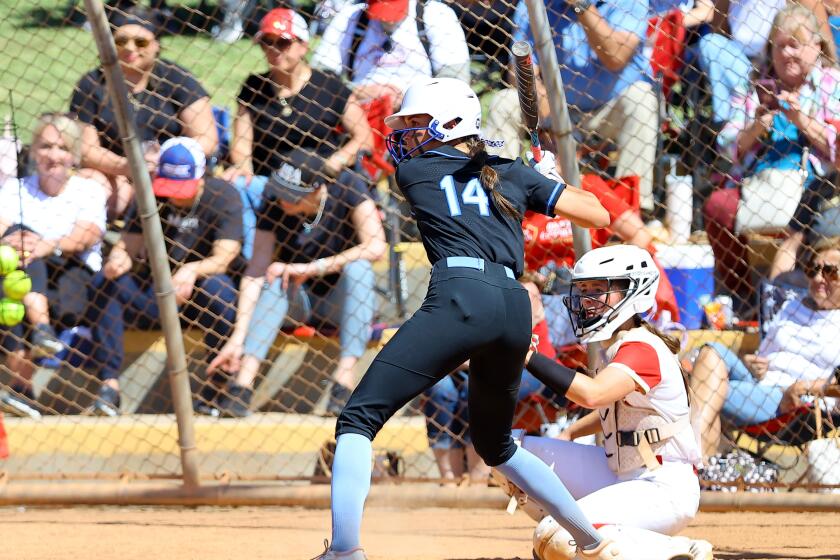They Gain a Bit More Seasoning : Prep Wednesday: High school basketball players are turning to community colleges to prepare them for Division I play.
- Share via
Erik Martin wasn’t ready. Neither was Eric Pauley. Nor Corie Blount. Nor Brett Pagett. Nor Cedric Ceballos.
And heaven only knows what a Division I coach would have thought of an awkward 7-foot center named Mark Eaton as a college freshman.
Great body, huge hands, but can he walk and chew gum at the same time?
But a funny thing happened on the way to basketball oblivion for these and many other players. Instead of throwing in the towel, they enrolled at a community college and, after two years of valuable tutoring and maturing, landed Division I scholarships.
Each player’s case is different. Some thought they were ready for the big-time right out of high school, only to find out they were wrong. Others knew there was no alternative because of poor grades or weak basketball fundamentals.
But their common route to success followed the well-worn path through community college basketball programs.
One season after leading Rancho Santiago College to its second consecutive State championship, Martin and Blount helped Cincinnati reach the Final Four.
Pauley, from Cypress College, is a starter for fourth-ranked Kansas.
After a false start at UC Irvine, Pagett went to Rancho Santiago and then became the starting point guard at Washington.
Ceballos, 17 when he graduated from high school, went to Ventura, then Cal State Fullerton and is in his third season with the Phoenix Suns.
And Eaton, who learned the game at Cypress and UCLA, still is plugging away after 11 seasons with the Utah Jazz.
Chew on that awhile.
When Bill Mulligan started his college coaching career at Riverside College, Jerry Tarkanian was at Pasadena City, Lute Olson was at Long Beach, Bobby Dye was at Santa Monica, Denny Crum was at Pierce and Jim Killingsworth was at Cerritos.
In the late 1960s, there were no better hands to mold and develop a community college player than those.
Now, among the most highly regarded coaches are Bill Brummel at Saddleback, Don Johnson at Cypress, Phil Mathews at Ventura and Dana Pagett at Rancho Santiago. And Mulligan at Irvine Valley.
After nine seasons at Riverside, five at Saddleback and 11 at UC Irvine, Mulligan returned to the community college level this season to help get Irvine Valley’s first season off the ground.
“The peer pressure on kids is unbelievable,” Mulligan said. “Kids say, ‘Where you going?’ How many of them are going to say Irvine Valley?”
It seems to be the No. 1 reason why more players don’t take advantage of the community college system, according to Mulligan.
High school basketball players seem swept up in a tide of Division I scholarship hysteria. So many leave with great expectations only to return deeply disappointed.
Not enough playing time. Homesickness. Coach too tough. Classes too tough. Simply not ready for Division I basketball.
There are many reasons why things don’t work out. But it’s not the end of the world, and often it makes a player more focused because he knows he’s down to his final chance.
“I always liked (recruiting) JC guys better because they really seemed humble,” Mulligan said. “They didn’t seem so big-time like high school guys.”
The key to moving on, community college coaches say, is a commitment to hard work.
“High school guys don’t realize how good JC basketball is,” Rancho Santiago College’s Pagett said. “For the first time they have to compete for a position.”
The battles are often fiercest along the front line.
“If you’ve got a big kid who’s motivated to work on his own, then he will improve,” said Cypress’ Johnson, the winningest community college men’s coach in state history.
Johnson has gained a reputation for molding lumps of coal into diamonds, having produced NBA centers Eaton and Swen Nater. If you’ve got height and heart, Johnson is the man to see.
He breaks down the position to its most elementary levels. Catch a pass, set your feet, pivot, shoot if it’s there, pass to a guard if it’s not. Repeat for hours on end.
“One or two basic shots are all the big kids need,” Johnson said. “If those become polished, if the kids know when and how to use them, then they can make an offensive impact.
“You know the player has arrived when he can say that the game is becoming easier. It takes a whole lot of time for that awareness to set in.
“On the JC level, the sophomore year is the great development year.”
Pauley was typical.
“Eric was such a good kid,” Johnson said. “We never had any problems with him. He did what we asked him to do, but sometimes he just felt he didn’t have that kind of future (at a top-25 program). As he began to play better, his stats improved and the media attention grew. I think Eric believed a little more in himself.”
Johnson’s most recent work in progress is Robbie Shelton, who was a promising player at Western High School but didn’t play his senior season.
“He’s clearly our best player,” Johnson said. “He’s improved tremendously. His attitude has improved, and he’s much more coachable. We just see a different Robbie Shelton, and I’m very proud of him.”
Dee Boyer, a 6-10 center, went through a similar growth period with Saddleback’s Brummel.
“I wasn’t physically ready,” said Boyer, who was told as much by a Nevada Las Vegas assistant coach.
At Saddleback, Boyer spent up to an hour after each practice working on drills to improve his center play. “Always with another big man,” he said. “We made a competition out of it.”
Said Brummel: “Dee is obviously still maturing. He definitely got better his second year. His mental approach to the game improved so much.”
Brummel, who spent a year as a volunteer assistant to Bob Knight at Indiana during the Hoosiers’ 1988-89 Big Ten championship season, said community college is the best preparation a Division I hopeful can get.
“The game is much faster, much more physical,” Brummel said. “It took Josh Borella all of last year to get in tune. Guys didn’t care about his reputation. They got in his face. Smart kids learn to make the adjustments.
“After 60 games, Division I coaches have a lot better product than if the kid just practiced with them. They know a player’s shortcomings after two years (at a community college).”
No dummies, Division I coaches have been quick to recruit the best community college players available. Sometimes, it’s the best way to keep a program winning.
Larry Johnson, a transfer from San Jacinto (Tex.), led UNLV to the NCAA title as a junior in 1989-90 and was the John Wooden award winner in 1991.
Last season, New Mexico State swept into the NCAA tournament’s Sweet 16 on the wings of a community college transfer-dominated lineup.
“Out here in New Mexico, there aren’t many Division I players coming out of high school,” Aggie Coach Neil McCarthy said. “We’re always out of state recruiting. We’ve been successful with junior college players. They are two years more mature physically. They’ve been away from home already.”
And last season, they helped the Aggies go 25-8.
Certainly there’s an easier route to a Division I scholarship than the one Chris Kostoff has taken. After graduating from Capistrano Valley in 1990, Kostoff attended Arizona State, Mesa (Ariz.) College, Butte College in Oroville, Calif., and UNLV before landing at Irvine Valley this past summer.
“My transcript is probably about as long as this couch,” he said gesturing to the beat-up piece of furniture in the Capistrano Valley locker room after playing in Irvine Valley’s first home game in school history.
“People laugh when I tell them my story.”
After two years away from the game, Kostoff called Mulligan and asked for a chance to play.
So far, he has made the most of it, averaging 24 points and turning heads with his three-point shooting ability. Now, he’s hopeful of earning a scholarship.
“(Mulligan) knows a lot of coaches around the country,” said Kostoff, a 6-2 freshman.
Said Mater Dei Coach Gary McKnight, who has sent more players to college over the last 10 seasons than any other county high school coach: “Look at Kostoff. He’s a rags to riches story.
“I think JC basketball is great basketball. So many times these kids are taught you need to be a Division I player (right out of high school) to be successful, and that’s a bunch of bunk.”
The opportunity to play, rather than sit on the bench and watch, is an all-important key to development, UCI Coach Rod Baker said.
“It’s a matter of competition and maturation,” Baker said. “You see so many kids go directly to a Division I school and there are great players ahead of them, so they sit and barely get in during garbage time. They’re missing a big part of the experience.
“Kids are very short-sighted. The peer pressure is really difficult. A kid has got to be able to have guidance from people around him. Also trust.”
After all, a little patience and a lot of growing up can pay big dividends in the long run.
Any doubters can ask Martin. Or Pauley. Or Blount. Or Pagett. Or Ceballos.
Or Eaton, the next time the Jazz is in town.
More to Read
Get our high school sports newsletter
Prep Rally is devoted to the SoCal high school sports experience, bringing you scores, stories and a behind-the-scenes look at what makes prep sports so popular.
You may occasionally receive promotional content from the Los Angeles Times.






